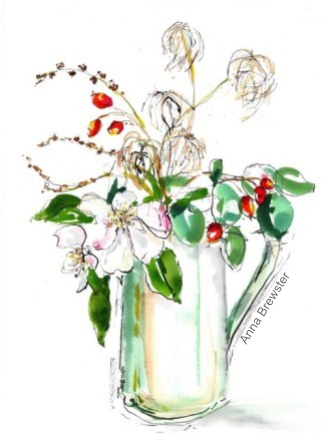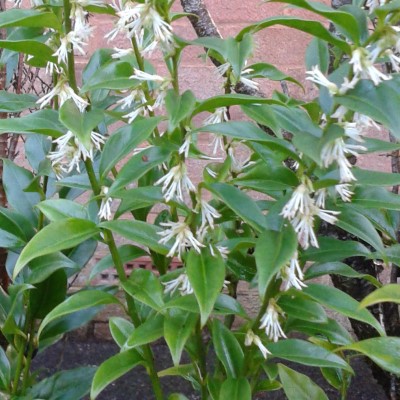 There is always room
for more bee- friendly
plants in your garden!
There is always room
for more bee- friendly
plants in your garden!
These images show both wild and cultivated plants through the year that are attractive to bees. Mostly shot in East Devon.
SPRING

Dandelion (Taraxacum officinale) is a good source of both nectar and pollen. Flowers March to October. The yellow pollen will stain the comb.

Blackthorn (Prunus spinosa) flowers March to April. Flowers open before the leaves. Useful for nectar and pollen.

Grape hyacinth (Muscari meniacum) flowers late March, early April. Provides much needed nectar and pollen at this time of year.

Chionodoxa (Chionodoxa spp) flowers in spring or, occasionally, autumn.

Skimmia (Skimmia spp) flowers in early Spring. Very attractive to bees (nectar and pollen). Beautiful scent. Suitable for a woodland garden.

Apples and crab apples. Illustrated is Malus floribunda, the Japanese crab apple. Flowers are produced in mid to late spring. Many crab apples are suitable for small gardens.

Pear (Pyrus communis) flowers April to May. As with apples, the saucer shaped flowers are readily accessible to bees.

Centaurea (Centaurea montana). This perennial Centaurea is attractive to bees and butterflies, and flowers from late spring to mid summer.

Poppy (Papaver spp). Brings lots of colour to your garden. Prefers full sun. Abundant pollen produced.

Limnanthus (Limnanthese douglasii) Often called Poached egg plant. Nectar-rich flowers are attractive to bees and hoverflies in May.

Scilla (Scilla spp) flower in spring, summer or autumn depending on the species and cultivar.

Allium (Allium rosenbachianum illustrated) easily grown in borders and troughs. Readily accessible flowers visited by honeybees, bumble bees, hover flies and butterflies.

Daisy (Bellis perennis). The common daisy will be visited by bees if there is nothing else around, so let your lawn daisies flower in April/May to provide extra forage.

Laurel (Prunus laurocerasus) has extra-floral nectaries on the underside of each leaf at the base. May be visited in April and May.

Broad bean (Visia faba) being ‘robbed’ by a honeybee. Three other robbed florets are visible.

Hawthorn (Crataegus monogyna) flowers late April to June. Classified as a major nectar source.
SUMMER

Cistus (Cistus spp), or Rock rose, has brightly coloured blooms which attract bees, mainly for pollen. Flowers from early to late summer but each flower lasts only one day.

Geranium (Geranium spp). The open flower structure makes the nectar accessible to a wide range of bees and other insects. Related to meadow cranesbill Geranium pratense and other members of the cranesbill family which are also good bee plants.

Angelica (Angelica archangelica) flowers May to August. Well worth planting in your garden. May grow to 7ft tall.

Knautia (Knautia macedonica). Grow in herbacious borders or cottage gardens where the flowers will be attractive to bees from mid to late summer.

Bramble (Rubus fruticosus) or blackberry has a long flowering period (May to October) so is a very welcome nectar and pollen source for honeybees and other insects.

Lovage (Levisticum officinale) grown in a herb garden will provide forage for numerous insects, including bees, in mid summer. Can grow to 8ft tall.

Bottle brush (Callistemon citrinus). This Australian shrub likes full sun and will provide forage for bees and other insects.

White Clover (Trifolium repens) is described as a ‘weed’ in lawns. However, if you let it grow in summer it will reward you with many types of visiting bee, including honeybees, from June to September.

Buddleia (Buddleia davidii) blooms in late summer and is attractive to all types of bees, flies and butterflies.

Goldenrod (Solidago spp). Produces abundant yellow flowers from July to October. Very attractive to bees and many other insects providing a useful late source of both nectar and pollen.

Yarrow (Achillea spp). Many species and cultivars to choose from for planting in gardens. Very attractive to bees and flies.

Dragonfly (Aeshna cyanea). The more flowers you have in your garden, the more insects will visit. This is a regular visitor in August/September.

Shirley poppies (Papaver rhoeas Shirley series) come in many shades of pink, red and white. Very attractive to honeybees and solitary bees. Pollen loads may look black.

Cornflower (Centaurea cyanus). Garden varieties of cornflower are much sought after by honeybees. All varieties appear to be nectar-rich.

Nasturtium (Tropaeolum majus) flowers have a long spur which secretes and collects nectar. This is readily available to long-tongued bumble bees, but pollen is available to honeybees.

Echinacea (Echinacea purpurea), sometimes called ‘cone flowers’, are related to the Rudbeckias and are good bee plants in late summer and autumn.

French marigold (Tagetes French series). There is a confusing array of cultivars, so plant types which have open flowers for insects to reach the pollen.

Ageratum (Ageratum houstonianum) or Floss flowers are attractive to butterflies and bees. In bloom from mid-summer to the first frost. Note the pure white pollen.

Sedum (Sedum spectabile), or ice plant, has numerous small star-shaped flowers arranged above the leaves. In September honeybees will visit in droves.

Rudbeckia (Rudbeckia fulgida). The conical centres of these daisy-like flowers are called ‘disc florets’ which last for long periods from summer to autumn. Attracts many species of insects including honeybees.
AUTUMN

Michaelmas daisy (Aster spp). Largely cultivated for late summer or autumn flowering. Most are freely worked for nectar and pollen. Very useful for forage later in the season.

Kniphofia (Kniphofia spp). Often called ‘Red hot pokers’. The spikes of tubular flowers are very attractive to bees and other insects. Sometimes, the nectar can be seen dripping from the ends of the flowers!

Comma butterfly on Helichrysum (Poligonia c-album on Helichrysum bracteatum). Another member of the Aster family attractive to many different kinds of insect in late summer and early autumn. The flower heads are ‘everlasting’ when dried.

Himalayan balsam (Impatiens glandulifera). This non-native, invasive species flowers from July to October. The nectar is easily reached by honeybees and bumblebees and, in doing so, they become covered in light coloured pollen from the anthers (white blob on image).

Ivy (Hedera helix). Greenish-yellow flowers appear from September to November. Excellent source of nectar and pollen used by all kinds of insects . The last important forage source for honeybees before the winter.
WINTER

Gorse (Ulex spp). Flowers somewhere in the UK all year round, especially during January, February and March. Provides nectar & pollen. Note the colour of the pollen.

Sarcococcus (Sarcococca hookeriana), often called winter box, is a winter flowering species with delightful scent attractive to honeybees.

Viburnum tinus (Viburnum tinus). Small flowers enable honeybees to collect nectar in the early part of the year whenever the temperature is above 10°C.

Lonicera fragrans (Lonicera fragrans). Flowers January – February. Fragrance detectable yards away making this attractive to honeybees.

Snowdrop (Galanthus spp.). Many varieties flowering from January to March. Good for pollen. Single varieties best for bees.

Wintersweet (Chimonanthus praecox). This unpreposessing flower lives up to its name! A useful addition to your garden apiary.

Primrose (Primula vulgaris). Very attractive and reliable wild flower, although bees don’t use it very often. Grows on most soils.

Camellia (Camellia spp). Many different varieties flowering from November to May. Single varieties best as bees can easily access the mass of pollen in the centre.

Hellebore (Helleborus spp). Lots of different species and varieties extend the usefulness of this plant from February to April. And they look good, too.

Hazel (Corylus avellana) catkins can provide bees with an additional pollen source between January and March. A sign that spring is on the way.

Alder (Alnus glutinosa) trees grow well near water. Like Hazel, the catkins can provide pollen early in the year (February to April).

Goat willow (Salix caprea). Image shows male catkins in March. Good for wet soils.

Pulmonaria (Pulmonaria officinalis) or Lungwort flowers February onwards. Bees will visit these flowers as soon as the air temperature is warm enough. Also sometimes called Soldiers and Sailors.

Winter heather (Erica carnea). The many varieties available enable gardeners to extend the usefulness of Winter heather. Some varieties may start flowering in November.

Mimosa (Acacia dealbata). Flowers February to April. Grows to 30ft or more. Intoxicating scent! Bees love it.

Mahonia (Mahonia spp). Flowers from November to March. Provides nectar & pollen. Honey scented flowers attractive to honeybees and bumble bees.

Winter heliotrope (Petasites fragrans). Flowers around January and February. An alien plant from the Med, only male plants grow here, so should provide pollen for bees. Heavily scented flowers.

Plants for Bees by Kirk and Howes is a mine of information on flowers suitable for bees. ISBN 978-0-86098 271-5. A copy is available in the branch library.